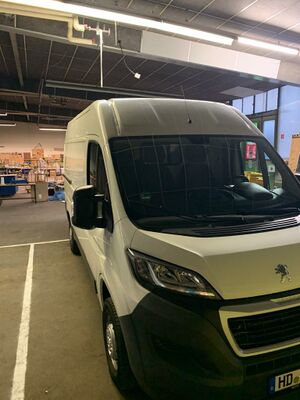Project:CamperVan: Difference between revisions
(insulation) |
|||
| Line 1: | Line 1: | ||
{{ProjectInfoBox|project title=Camper Van|status=In Progress|initiator=[[User:St3ffi|Steffi]] und [[User:Mfisch3r|Markus]]|date= | {{ProjectInfoBox|project title=Camper Van|status=In Progress|initiator=[[User:St3ffi|Steffi]] und [[User:Mfisch3r|Markus]]|date=June 2021 (started November 2020)|image=Camper Van.jpg|materials=[[Wood]]|software=}} | ||
== Motivation == | == Motivation == | ||
| Line 49: | Line 49: | ||
=== Clean-up and Rust Prevention === | === Clean-up and Rust Prevention === | ||
=== Setting up the Floor === | |||
=== Insulation === | === Insulation === | ||
<gallery mode="slideshow"> | This is a very special topic. There are very different opinion how a camper van should be isolated: | ||
File:Floor-insulation3.jpg| | |||
File:Floor-insulation2.jpg| | * not at all | ||
File:Floor insulation.jpg| | * wool or other natural material | ||
* styrodur and a moisture barrier | |||
File:Dividing wall insulation.jpg| | * armaflex | ||
File:Insulation-cord-hack.jpg| | |||
The option to use no insulation at all was never an option for us. We want to use the van also in cold climates (Norway in september/october....) and we believe that some kind of insulation will at least help use to keep the existing warmth inside. But you need to be aware that it is not easy to insulate a van. There are a lot of holes which you cannot reach and it is also quite common for this kind of vehicle, that there are holes which will lead condensed water out of the vehicle. | |||
We used armaflex since it is easy to handle (you can buy it with in a self-adhesive version), pretty much hydrophobic and hardly inflammable. There are different types of armaflex. We used armaflex xg which has almost the same quality attributes as the superior, and very expensive, armaflex af. Do not use armaflex ace since it is kind of an old version of the material. | |||
There are different sizes available. We used 19mm for the floor, ceiling and most of the walls. We also used 9mm for those parts which we will cover with wood. | |||
You can cut armaflex very easy with a sharp box cutter. <gallery mode="slideshow"> | |||
File:Floor-insulation3.jpg|We cutted lanes of armaflex for our floor. Make sure you clean the surface (with alcohol or something else) before you stick the armaflex to it. | |||
File:Floor-insulation2.jpg|Progress... | |||
File:Floor insulation.jpg|Floor already done. This took us about 2.5 hours | |||
File:Dividing wall insulation.jpg|For big parts like the dividing wall it is our recommendation to divide and conquer. It is much easier to handle. | |||
File:Insulation-cord-hack.jpg|For regions where you cannot put your hand in and reach the adhesive foil: use some cord and tie it to the adhesive foil. You can then use to remove the foil once your armaflex piece is in place. | |||
</gallery> | </gallery> | ||
=== Windows === | === Windows === | ||
Revision as of 21:11, 14 March 2021
| ProjectInfoBox Camper Van | |
|---|---|

| |
| Status: | In Progress |
| Release Date: | June 2021 (started November 2020) |
| Initiator: | Steffi und Markus |
| Materials Used: | Wood |
Motivation
Planning a Camper Van
Planning is a very important part of the process. You will buy a car, you will use it for some time and you have to live with all the decision you make. So take your time and think twice before building or buying the wrong stuff.
Vehicle Types
There are a lot of options but basically 3 types are relevant:
- Small transporters like Defender 110 or Volkswagen TX (where x is a number between 1 and 7) or Volkswagen Caddy or Volkswagen Sharan or something similar by any other manufacturer. You cannot stand upright in those vehicles except you install something like a roof tent.
- Medium transporters like Mercedes Sprinter, Fiat Ducato, Peugeot Boxer, Citroen Jumper. You can buy those cars in different sizes. Typically the names are like L1H1 (Length 1 and Height 1) which is the smallest option with a loading space of 2,67m (length) x 1,87m (width) x 1,66m (height) (Fiat Ducato) and L5H3 which is the largest option with a loading space of 4,07m (length) x 1,87m (width) x 2,17m (height). So there may be vehicles in which you are easily able to stand upright.
- Large Transporters like Renault TRM 2000, Mercedes Unimog 404 or 1300L or any other really big vehicle. You will almost always need a special driver license in germany for those cars.
Once you make up your mind you will have to decide between a fairly new vehicle or an oldtimer. We bought Peugeot Boxer L2H2 from 2016 which was in a good condition and is not that big. We still want to drive on small streets leading to nice mountains.
The Layout
The layout is very essential for your build. Our build has a fixed bed. A very good video with all pros and cons for fixed bed vs dinette: https://www.youtube.com/watch?v=Zz1fBVYK_2c&ab_channel=VanlifeSagas
Finding and Buying a Vehicle
Often you can find a van like a Peugeot Boxer from electricians or other craftsman. Typically you need to search in the news paper, mobile.de, autoscout24.de etc.
Beware: Try to buy your used car from a official dealer or from a private person. Used-car dealers often do not have any clue about the car and its condition. Sometimes they will even deny you the implied warranty. They just wanna earn quick money.
We bought our van from a official Peugeot dealer. We even got a one year guarantee in Europe.
Insurance and Registration
Plan your Build
Tools you will need
Probably at least:
Stuff you have to buy
Building the Camper Van
Clean-up and Rust Prevention
Setting up the Floor
Insulation
This is a very special topic. There are very different opinion how a camper van should be isolated:
- not at all
- wool or other natural material
- styrodur and a moisture barrier
- armaflex
The option to use no insulation at all was never an option for us. We want to use the van also in cold climates (Norway in september/october....) and we believe that some kind of insulation will at least help use to keep the existing warmth inside. But you need to be aware that it is not easy to insulate a van. There are a lot of holes which you cannot reach and it is also quite common for this kind of vehicle, that there are holes which will lead condensed water out of the vehicle.
We used armaflex since it is easy to handle (you can buy it with in a self-adhesive version), pretty much hydrophobic and hardly inflammable. There are different types of armaflex. We used armaflex xg which has almost the same quality attributes as the superior, and very expensive, armaflex af. Do not use armaflex ace since it is kind of an old version of the material.
There are different sizes available. We used 19mm for the floor, ceiling and most of the walls. We also used 9mm for those parts which we will cover with wood.
You can cut armaflex very easy with a sharp box cutter.






